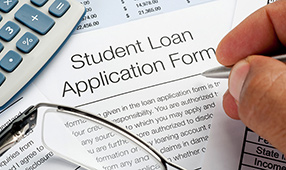College costs rise faster than inflation—and wages. And families have lots of other demands on their limited resources. So it’s understandable that when it comes to paying for a child’s college education or pursuing an advanced degree for yourself, loans are part of the equation.
Educators and their families have a variety of student loan options, directly from the federal government or through private lenders. But the different loan types and terms, along with their repayment plans or debt forgiveness programs, can be confusing to navigate.
Here are the key facts you need to know about student loan financing options to help you make an informed decision about how you pay for college.
First, look at the 3 types of federal student loans
Federal student loans are usually your best first option to explore when borrowing to pay for college. Not only do they have favorable, fixed interest rates and lenient repayment plans, but federal student loans also in certain cases will be eligible to be forgiven to reduce or eliminate your student debt. (Our NEA Student Debt Navigator is designed specifically to help teachers find debt cancellation and reduction options. You’ll learn more about that later in this article.)
To be eligible for a federal loan, you must fill out the Free Application for Federal Student Aid (FAFSA), beginning Oct. 1 of the year before the start of the academic year.
Here are the three types of federal student loans and how they can help you find money for college.
1. Direct Subsidized Loans
These are available to undergraduate students with financial need. Being “subsidized” means the government pays the interest on the loan while the student is in school.
The school determines how much you can borrow, although the government sets an annual cap of $5,500 to $12,500, based on your year in school and whether you’re a dependent. Only a portion of the loan—$3,500 to $5,000—is subsidized, with more assistance given to upper-level students.
2. Direct Unsubsidized Loans
These college loans are available to undergraduate, graduate and professional students regardless of financial need. The borrowing limits for undergraduates are the same as with subsidized loans. However, graduate and professional students can borrow up to $20,500 annually.
Interest charges begin to accrue once the loan is disbursed. You can postpone making payments while you’re in school, but that means your debt will grow and you’ll leave school owing more than you originally borrowed.
3. Direct PLUS Loans
There are two kinds of PLUS loans: One is for parents of undergraduate students (Parent PLUS Loans), and the other is for graduate and professional students (Grad PLUS Loans). You can borrow up to the cost of attendance, minus any financial aid received. The interest rate and fees on PLUS loans tend to be higher than with other federal loans.
Graduate students can take out an unsubsidized federal loan and a Grad PLUS Loan in the same year, if needed. Generally, they should borrow first using the unsubsidized loan because of its lower fees and interest rate, says Mark Kantrowitz, author of How to Appeal for More College Financial Aid. And if the $20,500 annual limit and other aid doesn’t fully cover the cost of attendance, they can borrow the rest using the Grad PLUS Loan, he says.
An added benefit of Direct PLUS Loans: They are eligible for loan forgiveness if borrowers work in public service (more information on that below). That means parents who are teachers could have their Parent PLUS Loan forgiven, even if the student doesn’t become an educator.
Unlike other federal loans, borrowers undergo a basic credit check and can be denied a PLUS loan if they have an adverse credit history, such as a tax lien, wage garnishment or a bankruptcy in recent years. Even with adverse credit, you could still qualify for a PLUS loan if you have an “endorser,” akin to a co-signer, who agrees to repay the loan if you don’t.
Need more money for college? Private student loans can fill the gap
Even with federal student loans, scholarships and grants, you may still have a financing gap, which can be filled with private student loans from banks or other institutions. Private loans require a credit review, which will determine whether borrowers qualify and at what interest rate.
NEA members have three unique private college loan options: the NEA Undergraduate Loan Program, the NEA Parent Loan Program and the NEA Graduate Loan Program. These loans are made through NEA Member Benefits’ partnership with College Ave Student Loans. All offer a 0.25% rate reduction to NEA members, plus another 0.25% rate decrease if you make automatic repayments from your bank account.
Borrowers can choose a loan term from five years to 15 years.1 Undergraduate and graduate borrowers have a choice of four repayment plans. Parents must begin repaying their loan once the money is disbursed, but they can opt to pay only interest on the debt while the student is still in school.
You may be wondering, should I cosign a student loan? For example, you may want to help a student who can’t get approved for a private or Grad PLUS loan based on his or her credit history. Although cosigning a college loan may improve the student’s chances of being approved and getting a better interest rate, you must be comfortable with taking equal responsibility for repaying the debt.
What’s more, cosigning a student loan can negatively affect your own credit score if the student is late on payments. If the student defaults on the cosigned student loan, the negative information will remain on your own credit report for seven years.
Also, getting student loans wiped out through bankruptcy is rare. Even if a co-signer succeeds in getting their obligation to repay a student loan discharged by a bankruptcy court, the student borrower remains responsible for repaying the debt, says student loan expert Kantrowitz. Likewise, if the student borrower gets the loan discharged in bankruptcy, the cosigner is still liable for the debt.
These adverse changes to your score or report can result in you paying a higher interest rate on a mortgage, refinancing or an auto loan.
Know your options when it’s time to repay student loans
For federal loans, you generally have a six-month grace period after you graduate, leave school or your enrollment drops below half time before repayments kick in. Repayments on Parent PLUS Loans typically begin once the loans are fully disbursed.
Under the standard repayment plan, borrowers make fixed monthly payments, and their debt is wiped out within 10 years. But if that payment plan is too burdensome for your budget, there are other options.
The Graduated Repayment Plan allows you to start off with smaller payments that gradually increase so your debt is repaid within 10 years. The Extended Repayment Plan is designed for those with more than $30,000 in federal loans and will eliminate your debt within 25 years.
The U.S. government also offers four income-driven repayment plans with a loan forgiveness feature. Depending on the plan, your payments are based on 10% to 20% of your discretionary income, a figure that’s calculated annually based on your income and family size. And any remaining balance after 20 to 25 years is forgiven.
Parent PLUS Loans are eligible for only one income-driven plan—the Income-Contingent Plan—provided that the loans have first been consolidated under the Federal Direct Consolidation Program.
In addition, the NEA Student Loan Refinance Program2, in partnership with College Ave Student loans, is a great way to potentially lower the interest rate or monthly payment you currently pay on your private student loans. NEA members also receive a special one-time statement credit equaling 0.5% of the loan, up to $599.993. To learn more, visit the NEA Student Loan Refinance Program.
You can prepare ahead for loan forgiveness for educators
There are options to have your federal loans forgiven within a shorter timeframe, if you’re eligible and have followed the repayment guidelines for several years after your schooling ends.
The Public Service Loan Forgiveness Program, for example, is designed for borrowers—students and parents—who work full-time for the government, at a public elementary or high school, or for a not-for-profit organization. You’ll need to enroll when you begin your teaching career to maximize your income-driven repayment plan and eventual forgiveness options. After you make 120 qualified monthly payments—or 10 years’ worth—any remaining loan balance is forgiven. Borrowers must be in an income-driven repayment plan to qualify.
Some forgiveness programs are specifically designed with educators in mind. Under the Teacher Loan Forgiveness Program, borrowers who have worked full time for five consecutive academic years at an elementary, high school or education agency serving low-income students can have up to $17,500 of their federal student loans forgiven.
And although government stopped offering Federal Perkins Loans in 2017, teachers with outstanding loans may be able to have some or all of their debt canceled. To qualify, you must be a full-time teacher at a public or private elementary or high school. And you must instruct students from low-income families, be a special education teacher, or teach certain subjects, such as math or foreign languages.
After you graduate and begin paying back your student loans, be sure to use the NEA Student Debt Navigator to see if you might have any federal repayment and loan forgiveness options. You can find a lot of information and support to navigate the Department of Education’s repayment and forgiveness options.
Consider that life changes can affect your ability to repay your student loans
Maybe your situation when you take out your student loans changes after you’ve graduated, and you end up having difficulty keeping up with your federal loan payments.
If that happens to you, start by seeing if you can switch to one of the income-based repayment plans noted above, which in some cases can reduce your monthly payment to $0. Or you might seek a temporary suspension of your payments through a deferment or forbearance. Ask your loan servicer about your options.
You can request a deferment if, say, you’re suffering economic hardship, returned to school for at least half time or enrolled in a graduate fellowship program. The length of deferment varies, but it can last up to three years if you’re unemployed or have another economic hardship. The interest on your loans will continue to accrue, although it will be paid by Uncle Sam if you have a subsidized loan.
A forbearance is granted up to 12 months at a time, but no more than three years total in certain cases, such as borrowers with financial difficulties. Interest continues to accrue on loans in forbearance.
If you have trouble meeting payments on private loans, contact your lender. Some offer forbearance or deferment for borrowers suffering economic hardship.
Weigh the benefits and risks before taking out loans for college
When managed prudently, student loans can help you or your children achieve educational goals. But they’re a legal obligation that comes with some financial risk. As you make college funding decisions, keep these college financing tips in mind:
- Consider your projected earnings before borrowing. Understand what you can expect to earn out of college and compare it to the cost of earning that degree or credential. To keep loans from getting too burdensome, some financial experts counsel students to never borrow more than their first year’s projected salary.
- Tap existing resources. Parents or older students already in the workforce might consider using more of their current income to pay school bills to reduce the amount of money they need to borrow from federal and private lenders.
- Keep a debt limit in mind. Even if you qualify for a large loan, you can prevent overborrowing by setting a personal cap that’s manageable.
1 This informational repayment example uses typical loan terms for a freshman borrower who selects the Flat Repayment Option with an 8-year repayment term, has a $10,000 loan that is disbursed in one disbursement and a 7.78% fixed Annual Percentage Rate (“APR”): 54 monthly payments of $25 while in school, followed by 96 monthly payments of $176.21 while in the repayment period, for a total amount of payments of $18,266.38. Loans will never have a full principal and interest monthly payment of less than $50. Your actual rates and repayment terms may vary.
2 The NEA Student Loan Refinance Program is provided by College Avenue Student Loans, LLC. College Ave Student Loans products are made available through Firstrust Bank, member FDIC, First Citizens Community Bank, member FDIC, or M.Y. Safra Bank, FSB, member FDIC. All loans are subject to individual approval and adherence to underwriting guidelines. Program restrictions, other terms, and conditions apply.
3 Amount equal to 0.5% of the initial loan balance to be credited on the borrowers statement within 60 days of closing of the loan. For example, if the consolidated loan equaled $20,000, the member benefit equals $100, with a maximum of $599.99.












